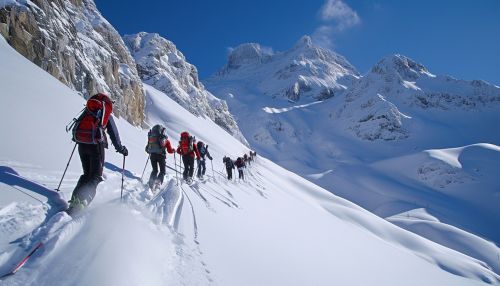Ski touring
Overview
Ski touring is a form of skiing where both uphill and downhill travel are possible without the need for ski lifts. This activity combines elements of cross-country, downhill, and backcountry skiing. Ski touring can take place in a variety of terrains, from groomed trails to backcountry areas.


History
The history of ski touring dates back to prehistoric times when people used skis as a mode of transportation in snow-covered regions. The earliest evidence of skis dates back to 6000 BCE in Russia. However, the concept of ski touring for leisure or sport is a relatively modern development, with the first ski touring clubs established in the late 19th century in Europe.
Equipment
The equipment used in ski touring differs from that used in resort skiing. Ski touring equipment is designed to allow for uphill travel and includes touring skis, bindings, boots, and climbing skins.
Touring Skis
Touring skis are typically lighter than alpine skis and have a wider tip and tail to provide better flotation in powder snow. They also have a camber and sidecut to allow for effective turning on downhill sections.
Bindings
Ski touring bindings are designed to allow the heel of the boot to lift off the ski while ascending and lock down for descending. There are two main types of touring bindings: tech bindings and frame bindings.
Boots
Ski touring boots are designed to be lighter and have a walk mode that allows for a greater range of motion in the ankle during ascent. They also have a stiffer mode for downhill skiing.
Climbing Skins
Climbing skins are strips of material that attach to the bottom of touring skis to provide traction for uphill travel. They are designed to allow the ski to glide forward but not backward.
Technique
Ski touring involves different techniques for ascending and descending. The ascent is typically achieved through a combination of walking and gliding, using climbing skins to prevent sliding backwards. The descent is similar to downhill skiing, with turns typically made in a parallel fashion.
Safety
Safety is a crucial aspect of ski touring. Risks include avalanches, changing weather conditions, and difficult terrain. Therefore, proper planning, knowledge of avalanche safety, and carrying appropriate safety equipment such as an avalanche beacon, shovel, and probe are essential.
Environmental Impact
Ski touring has a lower environmental impact than resort skiing as it does not require the construction and maintenance of ski lifts or the grooming of slopes. However, it can still have an impact on wildlife and vegetation, particularly in sensitive alpine environments.
